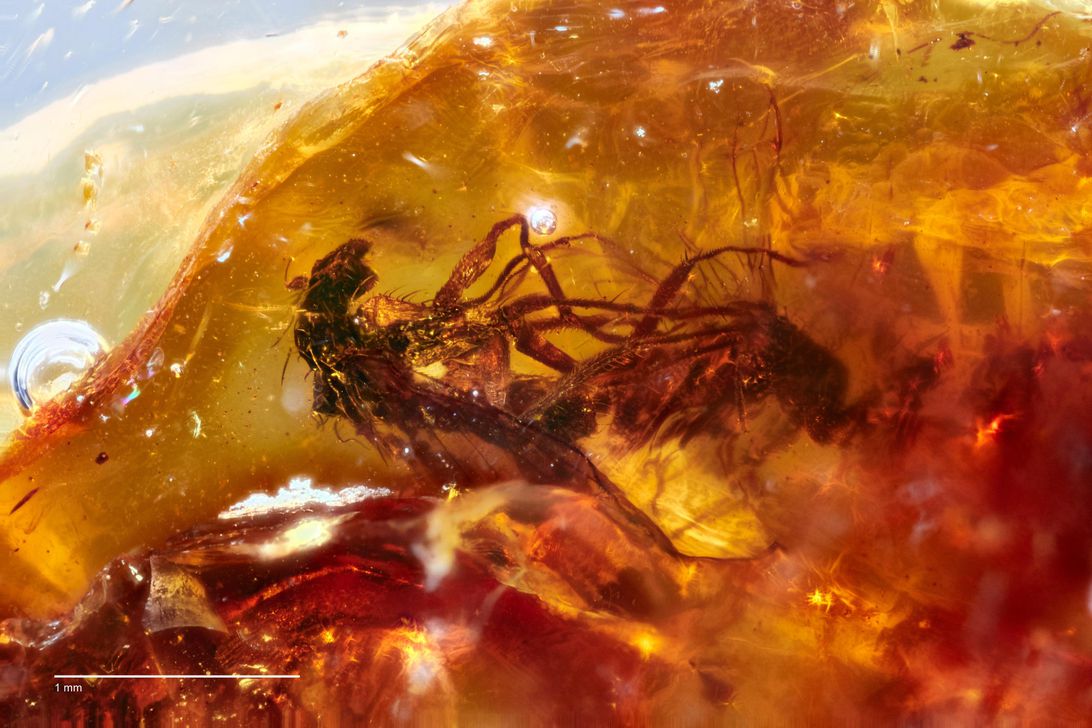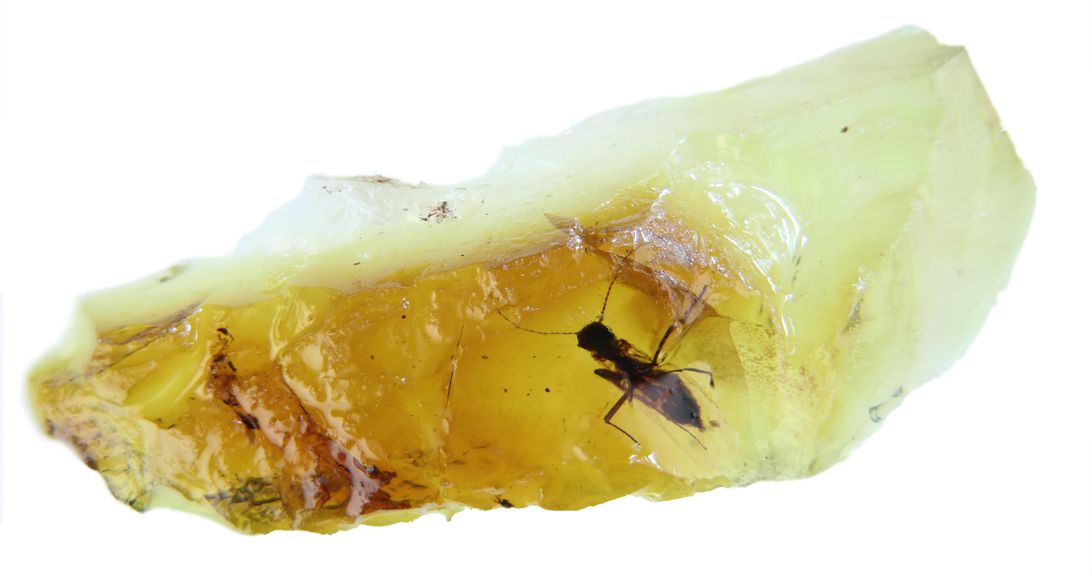Flies having sex preserved in fossil dating back millions of years
Though some couples boldly declare themselves to be so good at fornication they ought to be immortalized for it, they've been beaten to the punch by two long-legged flies preserved in amber.
A new study, published in the journal Nature on Thursday, suggests the flies are evidence of some of the oldest known Australian fossils to be preserved in amber. They're also potential candidates for the first frozen mating behavior to be listed in Australia's fossil record.

Led by a team from Monash University's School of Earth, Atmosphere and Environment in Melbourne, the study unearthed more than just some randy flies. Researchers also discovered the oldest known fossil ants from southern Gondwana, the first Australian fossils of wingless hexapods -- known as "slender springtails" -- a cluster of spiders, two liverwort, two moss species and biting midges, all encased in amber.

"Amber is considered to be a 'holy grail' in the discipline, as organisms are preserved in a state of suspended animation in perfect 3D space, looking just like they died yesterday," said Jeffrey Stilwell, a paleontologist at Monash University and the study's lead author, in a press release. "But in fact [they] are many millions of years old, providing us with an enormous amount of information on ancient terrestrial ecosystems."
The team -- made up of scientists from Australia, Spain, Italy and the UK -- studied amber pieces found in Tasmania's Macquarie Harbour Formation and Victoria's Anglesea Coal Measures, dating back over 50 million and 40 million years respectively.
"The research furthers our understanding of prehistoric southern ecosystems in Australia and New Zealand during the Late Triassic to mid-Paleogene periods (230–40 million years ago)," said Stilwell.
Sure we can all giggle about these long-legged flies getting caught with their long legs in a compromising position, but it's actually a huge step forward in learning more about Australia's prehistoric beasties and extrapolating what it might mean now.
"Our findings provide exciting new insights into the origin, antiquity and evolution of the modern Australian biota and show that there may be a vast potential for future, similar finds in Australia and New Zealand," said Stilwell.
You should read it
- $50 Free Chip Frenzy: Play and Win Big in Australia's Casinos!
- Horror with 100% real photos of horror shows that nature in Australia is scary
- Australia urged people to eat Kangaroo meat to protect the ecosystem
- Australia discovered dinosaur fossils turned into gems
- Signs that a part of mainland Australia once belonged to North America
- Marvelous revival life in the burning forests of Australia
- Stunned to find 250 ancient indigenous stone art sites in Australia
- The price of iPad 2 in Australia is second, behind the US
May be interested
- Found fossils of prehistoric 127 million year old small birds
 a scientist has discovered a small prehistoric fossil dating from the mesozoic era (250-65 million years ago) that helped them better understand the first small birds that appeared in the dinosaur era. .
a scientist has discovered a small prehistoric fossil dating from the mesozoic era (250-65 million years ago) that helped them better understand the first small birds that appeared in the dinosaur era. . - Mysterious mysteries of 2000-year-old caves on the precipice of 50m high in Nepal
 thousands of ancient caves dating back 2,000 years to the precipitous cliffs, some of them remain traces of people or many buddhist monuments dating from the 12th century to the 14th century. so far no one knows how those caves are dug, to whom and what their true functions are.
thousands of ancient caves dating back 2,000 years to the precipitous cliffs, some of them remain traces of people or many buddhist monuments dating from the 12th century to the 14th century. so far no one knows how those caves are dug, to whom and what their true functions are. - 6 'unique' points on Facebook Dating make Tinder obsolete
 compared to tinder - the dating app that was once considered the number 1, facebook dating was born later but it has impressive features that help users connect with each other better.
compared to tinder - the dating app that was once considered the number 1, facebook dating was born later but it has impressive features that help users connect with each other better. - 10 dating apps for girls and boys should not miss FA
 the best way to connect with someone is to go out and find a place to meet friends. however, with the development technology, there are many dating applications that can help the girls, the fa is busy finding the other half. this article will introduce you to the best dating apps, notes and find friends all over the place.
the best way to connect with someone is to go out and find a place to meet friends. however, with the development technology, there are many dating applications that can help the girls, the fa is busy finding the other half. this article will introduce you to the best dating apps, notes and find friends all over the place. - YMEETME, a serious dating app for Vietnamese people, marks 1 million users
 unlike normal dating apps, ymeetme is a designed and adjusted dating app exclusively for vietnamese.
unlike normal dating apps, ymeetme is a designed and adjusted dating app exclusively for vietnamese. - How to delete Facebook dating profiles, create new Facebook Dating
 old facebook dating profiles can be deleted to create a new facebook dating profile.
old facebook dating profiles can be deleted to create a new facebook dating profile. - The giant structure was discovered from mammoth bones 25,000 years ago
 scientists have discovered a giant structure made from more than 60 mammoth skeleton belonging to the ice age, dating back about 25,000 years ago.
scientists have discovered a giant structure made from more than 60 mammoth skeleton belonging to the ice age, dating back about 25,000 years ago. - Giant pandas may originate from Europe
 scientists have discovered fossils of ancient pandas that are thought to be over 10 million years old in hungary, according to a report in international science journal new scientist.
scientists have discovered fossils of ancient pandas that are thought to be over 10 million years old in hungary, according to a report in international science journal new scientist. - It took 1700 hours to describe the brain of 'fruit flies' in 3D
 scientists in tokai, japan spent 1700 hours to describe the brain of fruit flies with 3d images.
scientists in tokai, japan spent 1700 hours to describe the brain of fruit flies with 3d images. - Going to herd cow, accidentally discovered fossil 'monster' 20,000 years old
 this species is considered to be the ancestor of modern apricot species, which evolved in south america 30 million years ago before extinction at the end of the canh tan ten thousand years ago.
this species is considered to be the ancestor of modern apricot species, which evolved in south america 30 million years ago before extinction at the end of the canh tan ten thousand years ago.










 NASA brings famous 'worm' logo out of 28-year retirement for crewed SpaceX mission to ISS
NASA brings famous 'worm' logo out of 28-year retirement for crewed SpaceX mission to ISS Deep-sea rocks on Earth spark new hope for finding life on Mars
Deep-sea rocks on Earth spark new hope for finding life on Mars Confirmed coronavirus cases hit 1 million worldwide
Confirmed coronavirus cases hit 1 million worldwide Coronavirus: How to track the spread across the world as cases top 1 million
Coronavirus: How to track the spread across the world as cases top 1 million Coronavirus updates: New US jobless claims top 6.6 million, global coronavirus cases hit 1 million
Coronavirus updates: New US jobless claims top 6.6 million, global coronavirus cases hit 1 million 5 young lions collapsed giraffes
5 young lions collapsed giraffes